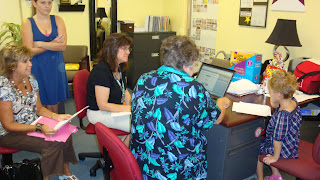I went to a departmentalized Grade 2 English Language Arts classroom while the students were at resource and the teacher was out of the room. What I learned is that you can find out a lot about a classroom by simply reading the room.

What I learned, in this particular classroom, is that there is an established Skills Block. Students have been learning high frequency spelling words and the language skills like nouns, verbs, and adjectives. Students have also reviewed punctuation. There is evidence of multiple presentation styles including embedded strategies in songs. In writing, students are working on Personal Narratives. They've learned about the story elements including how to make their seed idea grow, and how to sprinkle details throughout their writing. They've also learned how to write leads that engage the reader. In addition, students have learned editing skills to make their writing stronger. Students' writing samples are proudly displayed in the classroom and on the bulletin board in the hallway. And, they student has work in their writing journals tucked neatly in their desks.
Furthermore, it is very apparent that the teacher has provided an environment to grow an avid reader. There is an ample classroom library which includes a leveled library, genre library, and guided reading library. There are comfy reading nooks for students to relax and enjoy a good book. They've learned the habits of what good readers do, and have learned what a good listener looks like. The teacher has taught them the pro
 cedures for listening to a read aloud. Completed read alouds are displayed on a chart. The students are learning to identify the main idea in a passage or in their independent
cedures for listening to a read aloud. Completed read alouds are displayed on a chart. The students are learning to identify the main idea in a passage or in their independent  reading book, and are keeping book logs of the books they've read. I also noticed that the teacher has assessed students using the DRA 2, because on one table in the room the teacher has sticky notes with student's names listed on a pile of Guided Reading books. So, I assume her small groups will get started soon. The room is print rich. Vocabulary words, like contagious and distraction, are displayed on the word wall next to the Text Talk read aloud stories. In addition, students have an individual book bag with books that are on their reading levels.
reading book, and are keeping book logs of the books they've read. I also noticed that the teacher has assessed students using the DRA 2, because on one table in the room the teacher has sticky notes with student's names listed on a pile of Guided Reading books. So, I assume her small groups will get started soon. The room is print rich. Vocabulary words, like contagious and distraction, are displayed on the word wall next to the Text Talk read aloud stories. In addition, students have an individual book bag with books that are on their reading levels.I'm sure you would agree that reading the room is a valuable tool from the coaching perspective. You don't need long to get a snapshot of teaching and learning. And, it can be a valuable learning tool for other teachers. Visiting a colleague's classroom can inspire an "ahhh haaa" moment that may give you a fresh new idea.




 Wednesday was our first Early Release professional development session of the year. That means that we had approximately 80 minutes of dedicated time for quality teacher instruction.
Wednesday was our first Early Release professional development session of the year. That means that we had approximately 80 minutes of dedicated time for quality teacher instruction.








